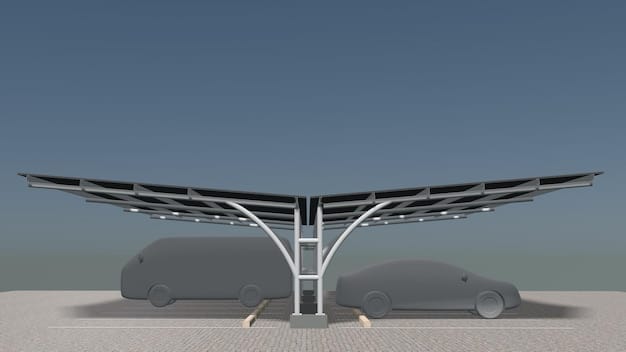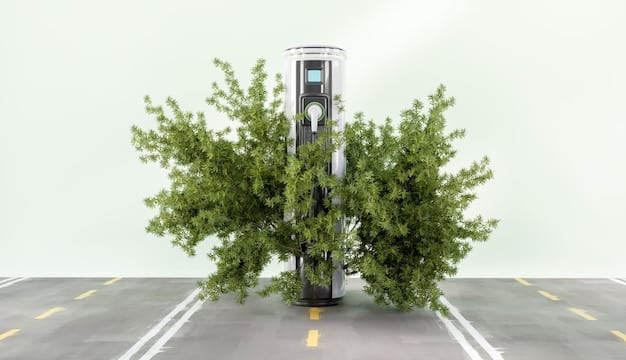US Auto Industry: Challenges & Opportunities in EV Transition

US auto manufacturers face significant challenges in transitioning to electric vehicle (EV) production, including high manufacturing costs, supply chain complexities, and the need for skilled labor, but also encounter considerable opportunities such as government incentives, growing consumer demand, and technological advancements.
The automotive industry is undergoing a profound transformation, with electric vehicles (EVs) poised to replace traditional combustion engine vehicles. This transition presents both significant challenges and exciting opportunities for US auto manufacturers in the transition to electric vehicle production. Navigating this evolving landscape requires strategic adaptation and innovation.
Understanding the Electric Vehicle Transition
The shift from gasoline-powered cars to EVs is driven by several factors, including environmental concerns, government regulations, and evolving consumer preferences. Understanding these drivers is crucial for US automakers as they plan their transition.
Environmental Concerns and Regulations
Growing awareness of climate change and air pollution has led to stricter environmental regulations worldwide. Governments are implementing policies to encourage EV adoption and reduce emissions.
Evolving Consumer Preferences
Consumer demand for EVs is increasing as technology improves, prices become more competitive, and charging infrastructure expands. Automakers must adapt to meet these changing preferences to maintain market share.
- Government incentives and subsidies are making EVs more affordable.
- Improving battery technology is increasing the range and performance of EVs.
- Expansion of charging infrastructure is making it easier for consumers to own EVs.
The EV transition represents a fundamental shift in the automotive industry. To succeed, US automakers must embrace innovation, invest in new technologies, and adapt to changing consumer demands. This proactive approach can transform potential challenges into opportunities for leadership and growth.

Key Challenges for US Auto Manufacturers
Despite the promising outlook, US auto manufacturers face numerous challenges in transitioning to EV production. These challenges range from high manufacturing costs to supply chain complexities.
High Manufacturing Costs
Producing EVs is currently more expensive than producing traditional vehicles. The cost of batteries, electric motors, and other components can significantly impact profitability.
Supply Chain Complexities
EV production relies on a complex global supply chain for critical materials like lithium, cobalt, and nickel. Disruptions in this supply chain can lead to production delays and increased costs.
Lack of Skilled Labor
The transition to EV production requires a workforce with specialized skills in areas like battery technology, electric motor design, and software engineering. Many US automakers face a shortage of skilled labor in these areas.
- Investing in workforce training programs to develop skilled labor.
- Securing stable and reliable supply chains for critical materials.
- Implementing strategies to reduce manufacturing costs and improve profitability.
US auto manufacturers must address these challenges head-on to remain competitive in the evolving EV market. Strategic investments in technology, infrastructure, and workforce development are essential for navigating these obstacles successfully.
Opportunities in the Electric Vehicle Market
Alongside the challenges, the EV transition presents significant opportunities for US auto manufacturers. These opportunities include government incentives, growing consumer demand, and technological advancements.
Government Incentives and Subsidies
Governments are offering various incentives and subsidies to encourage EV production and adoption. These incentives can help offset manufacturing costs and make EVs more affordable for consumers.
Growing Consumer Demand
As technology improves and prices decline, consumer demand for EVs is growing rapidly. US automakers have the opportunity to capture a significant share of this expanding market.
Technological Advancements
Ongoing technological advancements in battery technology, charging infrastructure, and autonomous driving are creating new opportunities for innovation and growth in the EV market.
- Developing advanced battery technologies with improved range and performance.
- Investing in the development of robust and reliable charging infrastructure.
- Integrating autonomous driving features into EVs to enhance safety and convenience.
By seizing these opportunities, US auto manufacturers can position themselves as leaders in the EV market and drive sustainable growth and profitability. Innovation, strategic partnerships, and a focus on consumer needs are key to unlocking the full potential of the electric vehicle market.

Investing in Charging Infrastructure
A robust charging infrastructure is essential for the widespread adoption of EVs. US auto manufacturers have a crucial role to play in expanding and improving the charging network.
Public Charging Stations
Investing in the deployment of public charging stations is crucial for making EV ownership more convenient and accessible. Automakers can partner with government agencies and private companies to expand the public charging network.
Home Charging Solutions
Providing home charging solutions can make EV ownership more practical for consumers. Automakers can offer incentives and support for installing home charging equipment.
Fast Charging Technology
Developing and deploying fast charging technology can reduce charging times and make EVs more appealing for long-distance travel. Automakers can invest in research and development to improve fast charging capabilities.
- Partnering with energy companies to develop smart charging solutions.
- Offering incentives for consumers to install home charging equipment.
- Investing in the development of ultra-fast charging technology.
Expanding and improving the charging infrastructure is critical for overcoming range anxiety and accelerating EV adoption. US auto manufacturers must work collaboratively with stakeholders to create a seamless and convenient charging experience for EV owners.
The Role of Government Policies
Government policies play a significant role in shaping the EV market. US auto manufacturers need to stay informed and engage with policymakers to ensure a supportive regulatory environment.
Tax Incentives and Rebates
Tax incentives and rebates can make EVs more affordable for consumers and encourage adoption. Automakers can work with policymakers to extend and expand these incentives.
Emission Standards and Regulations
Stricter emission standards and regulations can drive demand for EVs and accelerate the transition. Automakers can advocate for policies that promote EV adoption and reduce emissions from gasoline-powered vehicles.
Infrastructure Investments
Government investments in charging infrastructure can support the growth of the EV market. Automakers can work with policymakers to secure funding for infrastructure development.
- Advocating for policies that promote EV adoption and reduce emissions.
- Supporting government investments in charging infrastructure.
- Engaging with policymakers to ensure a supportive regulatory environment.
Government policies can create a level playing field and accelerate the transition to electric vehicles. US auto manufacturers must actively engage with policymakers to ensure that regulations and incentives are aligned with the industry’s long-term goals.
Strategies for Success in the EV Transition
To succeed in the EV transition, US auto manufacturers need to adopt a comprehensive and strategic approach. This includes investing in research and development, building strategic partnerships, and focusing on customer satisfaction.
Investing in Research and Development
Investing in research and development is essential for developing advanced EV technologies and staying ahead of the competition. Automakers should focus on improving battery technology, reducing manufacturing costs, and enhancing performance.
Building Strategic Partnerships
Building strategic partnerships with technology companies, suppliers, and other stakeholders can provide access to new technologies, expertise, and resources. Automakers can collaborate with partners to accelerate innovation and reduce costs.
Focusing on Customer Satisfaction
Focusing on customer satisfaction is crucial for building brand loyalty and driving EV adoption. Automakers should prioritize the customer experience and provide excellent service and support.
- Prioritizing customer feedback and incorporating it into product development.
- Building a strong brand identity and reputation for quality and reliability.
- Offering competitive pricing and financing options to make EVs more accessible.
A strategic and customer-centric approach is essential for navigating the EV transition successfully. US auto manufacturers must embrace innovation, build strong partnerships, and prioritize customer satisfaction to thrive in the evolving automotive market.
| Key Point | Brief Description |
|---|---|
| ⚡️ High Manufacturing Costs | Producing EVs is more expensive due to battery and component costs. |
| ⛓️ Supply Chain Complexities | EV production relies on complex global supply chains for critical materials. |
| 🧑🔧 Lack of Skilled Labor | There is a shortage of skilled labor in battery technology and EV engineering. |
| 💰 Government Incentives | Government incentives help offset manufacturing costs and consumer prices. |
Frequently Asked Questions
▼
The biggest challenges include high manufacturing costs related to battery production, establishing reliable supply chains for essential materials, and the need to develop a skilled workforce capable of handling EV technology.
▼
US automakers can capitalize on opportunities by leveraging government incentives, catering to growing consumer demand for EVs, and investing in cutting-edge technological advancements to enhance efficiency and performance.
▼
Charging infrastructure is critical; widespread and reliable charging stations alleviate range anxiety and encourage EV adoption. Automakers and governments must collaborate to expand and improve the charging network.
▼
Key policies include tax incentives, rebates for consumers, stringent emission standards, and infrastructure investments. These measures can make EVs more accessible and support the growth of the EV market.
▼
Successful strategies involve investing heavily in research and development, building strategic partnerships with technology firms, and prioritizing customer contentment by providing competitive offerings and superior service in the EV market.
Conclusion
The transition to electric vehicles presents both formidable challenges and significant opportunities for US auto manufacturers. By addressing the challenges related to manufacturing costs, supply chain complexities, and workforce development, and by capitalizing on opportunities such as government incentives, growing consumer demand, and technological advancements, US automakers can successfully navigate the EV transition and maintain their competitive edge in the global automotive market.





